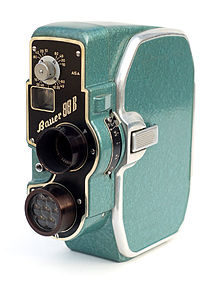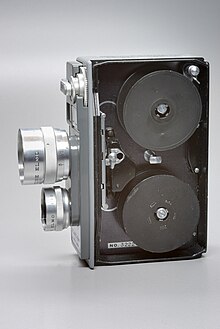Normal 8
Normal-8 is a small film - format , which in March 1932 by Eastman Kodak brought to market with the introduction of Super-8 was quickly replaced in May 1965 by this. According to the most common assembly, one also speaks of double-8 .
distribution
Emergence

In order to save film costs, the well-known 16 mm film was made into an amateur film by exposing it to half the length twice and then cutting it in half lengthways after development. As a result, the usable image area was reduced from 7.2 mm × 9.6 mm for 16 mm film to 3.6 mm × 4.8 mm, i.e. by a factor of 4. The modern high-resolution film emulsions still ensured sufficient image quality, see above that as early as the late 1930s, 8 mm cameras were twice as common as 16 mm cameras.
The advantages of 8 mm film lay in smaller cameras, but above all in the considerably lower costs for equipment and film material, which in the first place made private films possible on a larger scale.
Agfa had introduced another advantage with the Movex film cassette and its simple film change, but the system could not prevail.
decline
The disadvantage of this procedure were the disproportionately wide perforation holes for the narrow film , which ultimately led to the Super 8 film, in which a narrower perforation with a longer film step offered a larger image format and thus a superior image quality in terms of resolution. On the one hand, this led to the designation Normal-8 (English Regular-8 ) for the previous film, previously one only spoke of 8-mm film; on the other hand to the decline of the format to the extent that soon no more new devices were offered. With regard to the picture position , however, Super-8 remained inferior to its predecessor format. The reason for this lies in the upright arrangement of the perforation holes. In contrast to all other film formats, Super-8 and Single-8 do not have transverse holes.
The transition from Normal-8 to Super-8 took place very quickly, with used devices losing about half their value. Regardless of this, double-8 raw film has remained on the market to this day, black and white and for color.
Movies
Double 8
The most widespread were open daylight coils with 7.5 m (usable length 7.62 m or exactly 2000 images) of film material, which is split lengthways after development in the laboratory and then glued together to double the length. It was possible to record for two minutes in one camera run at 16 frames / s, then the two coils were swapped for the second run. Individual cameras could also record 15 m spools and some brands 30 m spools, which allowed a total of 16 minutes of recording time. These include the Fairchild Cinephonic 8 (COMMAG), the GIC 8, the Pathé Lido 8, the Honeywell-Elmo-Ilford C 300 and the Paillard-Bolex H-8. The Japanese Sekonic Dualmatic and Dual Run, in which the film chamber and the clamped film are rotated by 180 degrees, offered a clever solution for the task of turning the film.
Movex
The Movex cassette, introduced in 1937, had two coils lying in one plane, making it look similar to the single-8 cassette. It took 10 m of film, with no second run, and could be bought ready-made. Agfa offered cameras for this system until 1956 and then switched to double-8 cameras due to lack of success.
Other cassettes and reels
Other companies also offered double-8 or normal-8 film in cassettes, such as: B. Kodak . However, since no uniform standard could prevail, these systems quickly met the same fate as the Movex system. In the USA, 8 mm wide films on daylight reels were also on the market. Other cassette systems from different manufacturers had to be loaded onto daylight reels by the user himself beforehand with double-8 film. Sometimes this service was also offered by photo dealers.
emulsion
Normal 8 color films had artificial and daylight color films.
Cameras
drive

In contrast to Super-8, the electric drive was not yet a matter of course in the normal-8 period, it only appeared in the end phase. Previously, the film was transported with a spring mechanism , you had to wind the camera spring and then you could usually record for about 30 seconds without interruption. Individual models with double or repositioning springs run for 67 seconds or even more than two minutes. These are the English Specto 88 and the Agfa-Movex Reflex.
Lenses
It was similar with zoom lenses. Simple cameras only had a fixed focal length , more expensive models had a revolver with several lenses . From 1959 models with zoom lenses came onto the market.
speed
When it comes to silent films, the exact screening speed is not so important, the camera's spring mechanism drives did not keep the speed exactly, at least the accuracy of the centrifugal governor for synchronous sound was not sufficient over longer passages.
Playback devices
There has been a wide variety of normal-8 projectors, from toy devices for children to simple models that can be switched on and off to remote-controlled devices. With good projectors, a motion picture up to two meters wide can be played in convincing quality. Above all, more expensive lenses are used.
So-called film viewers are useful when you start editing films. According to the principle of optical image tracking through a polygon prism, the film can be viewed at any speed until it comes to a standstill. Pocket film viewers were also known.
In the 1930s, projectors that took up 300-foot reels were sold (a foot of 8-mm film runs for five seconds at 16 km / h). The reel size 400 feet (122 meters) is widespread, with which the playing time at 16 km / h can be thirty-three minutes.
Sound film
Normal-8 was mostly used to shoot silent films, only committed amateurs had been producing sound films since the early 1950s, which was always done with the two-band process (see Super 8 ) on the recording side . There was a SEPMAG projector, the Siemens & Halske 800, which plays image and magnetic film parallel to one another. The device takes 2000-foot reels (610 meters), which means that playing times of up to 111 minutes are possible with 24 B./s.
The screening mostly ran according to various two-band procedures , but sound film projectors were already emerging in the 1960s, although they were expensive and, as a result, not very common. These projectors worked with a magnetic track that had to be attached to the film later, which, in contrast to Super-8, was next to the perforation. For various reasons, the sound quality of the magnetic edge track sound in Normal-8 was rather modest, so that most amateur sound films were set to music and shown with different two-tape methods. The Association of German Film Amateurs tried to establish the ETS procedure (standard sound system) with synchronizing pulses for every 4 images as the norm, but this did not really succeed.
Individual evidence
- ↑ "Kleines Kassettenchaos", Siegbert Fischer, narrow film 4/2005, p. 42ff



